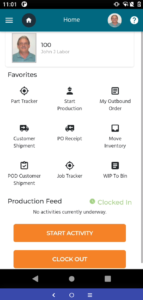
Brought to you by Epicor
A bird’s-eye view of the supply chain

April 22, 2024
By Plant
Manufacturing supply chain professionals have faced unprecedented upheaval over the past few years in the wake of a global pandemic, political unrest, port congestion or closures and extreme weather events.
“It has become increasingly clear that gaining visibility into all aspects of your supply chain has to be a priority for forward-thinking manufacturers,” says Kerrie Jordan, group vice-president of product management for enterprise resource planning (ERP) software company Epicor.
The good news, she says: by combining ERP and supply chain management (SCM) software into a single technology solution, manufacturers can access the tools they need to “more easily navigate today’s unpredictable and dynamic industrial and economic landscape, while still managing growth and profitability within their businesses.”

Photo courtesy of Epicor.
The benefits of an SCM strategy
At its core, an effective SCM strategy allows businesses to track and monitor all parts of a supply chain in real time or near real time. This creates a bird’s-eye view of inventory levels, order processing, production schedules, shipment and logistics operations, as well as the status of goods as they make their way through the supply chain.
SCM software collects and incorporates information from a variety of inputs, including ERP systems, and digital tools like Internet-of-Things devices, RFID technology and advanced analytic platforms. It then analyzes that data across various stages of the supply chain, allowing users to react quickly to potential problems, revise timelines and make updates that improve operational efficiency.
Equally as important, says Jordan, when SCM software is seamlessly integrated with an ERP system, users have access to a single source of truth across the supply chain. Quantifiable benefits of this combined system, outlined in a new report from Nucleus Research, include:
- 19 per cent increase in demand forecast accuracy,
- 18 per cent improvement in on-time, in-full (OTIF) service levels, and
- 16 per cent decrease in the cost of goods sold (COGS).
Integrating ERP and SCM enables better collaboration between departments and provides “information at your fingertips,” Jordan says, “because things happen fast and you have to be able to make decisions quickly.”
Where does AI fit?
SCM software makes use of artificial intelligence (AI) technology that simulates human intelligence and problem-solving capabilities. This can optimize supply chain activities, from monitoring product quality to balancing inventory levels and identifying fuel-efficient delivery routes.
For example, explains Jordan, if inventory supply is disrupted for some reason (such as the shutdown of a major port, like the Port of Baltimore), an effective SCM system should notify the user instantly and provide a list of potential replacement suppliers, along with all the pertinent facts about them and even a rating score card.
“You need to know which suppliers would be recommended to work with you based on the parameters of where you operate,” she says. “Things like, who are your customers and what local regulations does the supplier have to comply with given the regions where you do business?”
AI can also help control inventory and logistics costs by providing real-time information and accelerating decision making. If demand is surging for a specific SKU, powerful AI-driven analytics can quickly pick up on the change and suggest a procurement schedule to meet that rising demand without overpaying for rush deliveries or keeping high levels of stock on hand. Users can also run “what-if?” forecasting scenarios that show the likelihood and outcome of future events (think changes in demand or supply chain risks), as well as the potential impact on budget and timelines.
Don’t ignore the prep work
When it comes to implementing a solid SCM strategy, Jordan notes, savvy manufacturers begin by thinking carefully about what they wish to achieve; then lay out clearly stated business goals with agreed-upon objectives, metrics and milestones.

Optimize workflows with wireless warehouse. Photo courtesy of Epicor.
For example, Jordan suggests, one may target cutting down on waste or reducing material costs; or prioritize ensuring customers get their deliveries on time and in full, without breakage. “You wouldn’t be going through this process if there wasn’t room for improvement,” Jordan contends. “So I think it’s important to have an open mind and really look at the individual processes.”
Once business goals are clear, Jordan advises auditing the current IT system to identify challenges in data – things like missing or repetitive information. “By addressing low-quality or missing data you can really improve your overall ERP and supply-chain system,” Jordan says.
Getting SCM up and running
When evaluating an ERP, Jordan advises, it’s wise to seek out a partner that has experience in the specific industry and country a company operates in. An ERP partner should help guide users through the implementation process, she adds. “This can be a challenging endeavor,” she says, “and it’s not something you need to do on your own.”
Epicor’s approach, she says, is to offer a modular system of SCM, with logistics solutions, delivery and dispatch solutions and shipping solutions that customers can add on to as needed. That way, one module will be up and running before moving on to the next.
“We generally encourage our clients to tackle implementation in phases, starting with the area of greatest pain,” Jordan explains. “That way they can capture those quick wins. Once they do that, they’re able to energize the team because they’re seeing the value. They can use that ROI gained to fuel the rest of their journey and get to their ultimate destination.”
Cloud or on-premise system?
Cloud-based software isn’t right for every manufacturing business – those in aerospace and defense, for example, may choose an on-premises solution. But, Jordan believes cloud-based systems, such as Epicor Kinetic, are a natural fit for many manufacturers.
A cloud-based platform uses Internet-of-Things (IoT) technology to feed the ERP real-time information about the location, quantity and condition of goods within a supply chain long before they’ve arrived at a warehouse or customer’s door, she points out. If an order is delayed due to bad weather along the route, for instance, the user will know instantly and can respond quickly.
The power of real-time data to offer increased visibility into supply chains is part of the reason that enterprises around the world are increasingly opting for cloud-based technology, according to the Manufacturing Industry Insights Report from Epicor.
Fully 90 per cent of Epicor’s survey respondents cited the need to use the latest technology to get ahead as the reason they plan to move to a cloud-based system this year. There’s no doubt, says Jordan, “supply chain visibility can be greatly enhanced with ERP in the cloud.”
